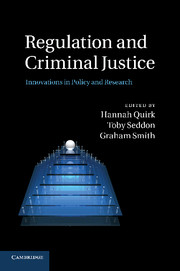Book contents
- Frontmatter
- Contents
- List of figures and tables
- Notes on contributors
- Foreword
- Acknowledgements
- 1 Regulation and criminal justice: exploring the connections and disconnections
- PART I Regulation and criminal justice: framing the debate
- PART II Criminal justice as regulation: responsivity, alternatives and expansion
- PART III Regulation of criminal justice: monitoring, effectiveness and accountability
- 10 The regulation of criminal justice: inspectorates, ombudsmen and inquiries
- 11 Rethinking prison inspection: regulating institutions of confinement
- 12 Regulating democracy: justice, citizenship and inequality in Brazil
- Index
- References
11 - Rethinking prison inspection: regulating institutions of confinement
Published online by Cambridge University Press: 04 February 2011
- Frontmatter
- Contents
- List of figures and tables
- Notes on contributors
- Foreword
- Acknowledgements
- 1 Regulation and criminal justice: exploring the connections and disconnections
- PART I Regulation and criminal justice: framing the debate
- PART II Criminal justice as regulation: responsivity, alternatives and expansion
- PART III Regulation of criminal justice: monitoring, effectiveness and accountability
- 10 The regulation of criminal justice: inspectorates, ombudsmen and inquiries
- 11 Rethinking prison inspection: regulating institutions of confinement
- 12 Regulating democracy: justice, citizenship and inequality in Brazil
- Index
- References
Summary
Closed institutions of all kinds – prisons, juvenile detention centres, police lock-ups, secure psychiatric wards, immigration detention centres and similar custodial services – pose accountability challenges for democratic societies.
(Harding 2007: 543)
Introduction
The need to shine a light into the closed world of prisons has been recognized for a very long time. In Britain, the ‘official’ inspection of prisons dates back to 1835, when its first emergence was part of the broader ‘revolution in government’ in the middle of the nineteenth century during which much of the administrative machinery of the modern state was assembled (MacDonagh 1958; Braithwaite 2003: 10). But the question of external scrutiny of prisons had also been widely discussed in the previous century, notably by the prison reformer John Howard in his classic The State of the Prisons first published in 1777 (see Stockdale 1983). Indeed, we can trace this back even further: medieval prisons were sometimes subject to inspection (Peters 1995: 29, 36), as were some in the ancient world, notably in the Roman Empire (Peters 1995: 19).
Today, the inspection of prisons is carried out across the world by a range of national bodies, as well as by supranational organizations such as the European Committee for the Prevention of Torture and the Special Rapporteur on Prisons and Conditions of Detention in Africa. The United Nations Optional Protocol to the Convention against Torture and Other Cruel, Inhuman or Degrading Treatment or Punishment (Opcat) came into force in 2006, requiring signatories to put in place adequate inspection arrangements.
- Type
- Chapter
- Information
- Regulation and Criminal JusticeInnovations in Policy and Research, pp. 261 - 282Publisher: Cambridge University PressPrint publication year: 2010
References
- 2
- Cited by



